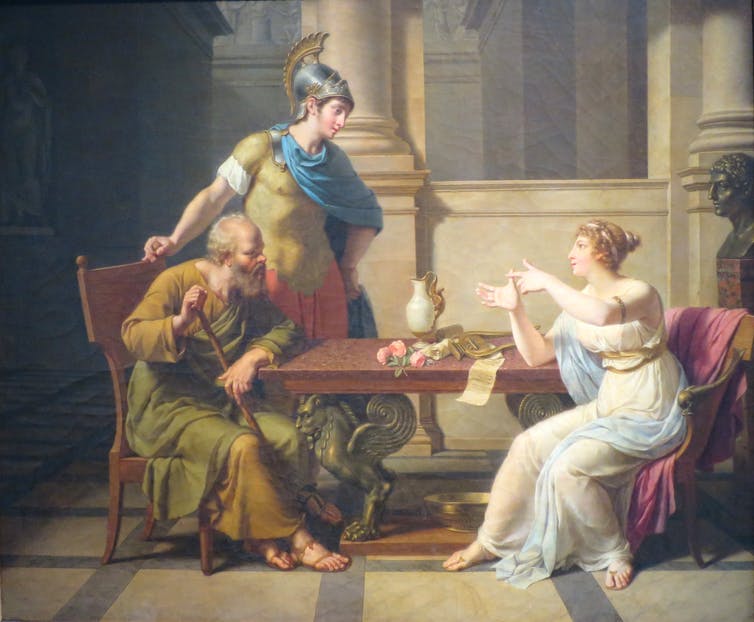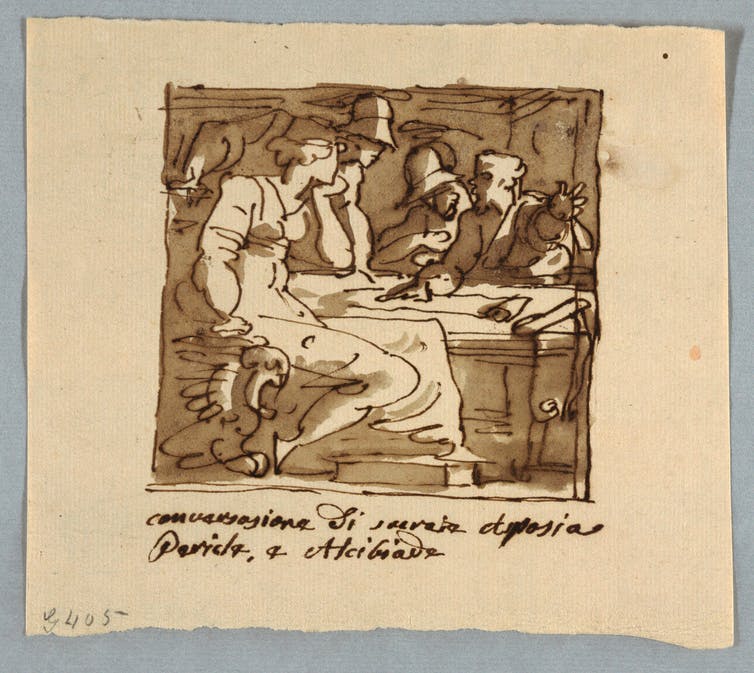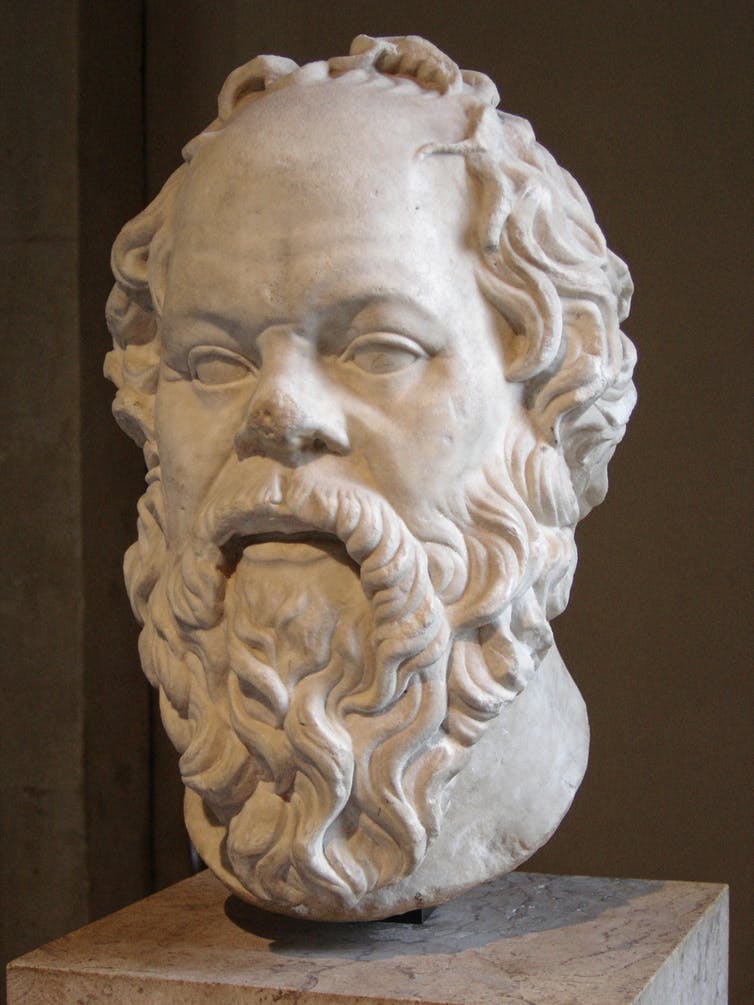Socrates in love: who actually laid the foundations of Western philosophy
Dear women! I congratulate you on International Women's Day and spring has finally come.
Although I was a little late in my congratulations, I think I will be forgiven. And as a gift, I propose a translation of an article about the role of women in History ...

Where did Socrates, the founder of Western philosophy, draw inspiration from for his original ideas about truth, love, justice, courage and knowledge? A new study that I conducted shows that, being a young man in the 5th century BC. e. In Athens, he communicated with an extremely intelligent woman, Aspasia of Miletus. I argue that her ideas about love and superiority inspired him to formulate key aspects of her ideas, as Plato conveyed.
If evidence of this thesis is accepted, a serious revolution awaits the history of philosophy: a woman who has been almost erased from history should be recognized as the founder of our 2500-year-old philosophical tradition.
The 19th century neoclassicist painter Nicolas Monceau's picture depicts Socrates sitting at a table opposite a luxuriously dressed, gesturing Aspasia. Beautiful young soldier Alcibiades looks at her. The image captures the standard idea of Socrates: the poor and the ugly. The son of a bricklayer, from middle age, he was known for walking without shoes and wearing torn clothes.

Fig_1. Debate of Socrates and Aspasia.
But Socrates also, according to Plato, was trained in the eloquence of Aspasia, who for more than ten years was the companion of the leading statesman of Athens Pericles. A supposedly highly educated “courtesan,” Aspasia is depicted in a picture that lists moments of conversation on her fingers. Her gaze is directed at the aristocratic youth of Alcibiades, who was a pupil of Pericles, and, probably, the grandnephew of Aspazius. As Socrates claimed, she was fascinated by the beauty and charisma of Alkibiades, and, as described in the Platonic dialogue at the symposium, he saved her life in the battle of Potidea in 432 BC.
Is this picture fair to Socrates? His main biographers, Plato and Xenophon, knew him only as an elderly person. But Socrates was once young, and was a direct contemporary of Aspasia. And the surviving descriptions of the philosopher, rare information given by his biographers, and the ancient written texts, which were generally ignored or misinterpreted, draw a different picture of Socrates: he is a well-educated young man who grew up to become a no less brave soldier than Alcibiades, and passionate lover of both sexes is no less intense thinker and debater.

Pic_2. Socrates found Alkibiades in the house of Aspasius.
Diotima / Aspasia
Socrates is known for saying: “The only thing I know is that I do not know anything.” But Plato, in a symposium (199b), reports that he learned the “truth of love” from a skilled woman. That woman received the name “Diotima” - and at the symposium Socrates sets out her teachings.
Scientists almost universally reject Diotima as fiction. In the dialogue, she is described as a priestess or a prophet and is considered, at best, an allegorical figure — inspiration or a diviner of wisdom that could devote a thinker, such as Socrates, to the secrets of love. But Plato leaves some curiously accurate clues about the personality of Diotima, which until now had never been clarified. In my book, I present evidence that “Diotima” is in fact a thinly veiled disguise for Aspasia.
Aspasia came from a noble Athenian family, a relative of the family of Pericles, settled several decades earlier in the Greek city of Miletus in Ionia (Asia Minor). When she moved to Athens around 450 BC, she was about 20 years old. Socrates, too, was about 20 years old.
A few years later, Aspasia became attached to Pericles, who at that time was the leading politician in Athens - and already twice her age. But Aristotle's disciple, Clearch, notes that "before Aspasia became the companion of Pericles, she was with Socrates." This is consistent with other evidence that Socrates was part of the entourage of Pericles in his youth. He would certainly have met Aspasia in that setting.

Fig_3. Socrates, Pericles, Alcibiades, Aspasia at the debate.
Considering that in his youth he was part of this privileged elite, what prompted Socrates to turn to being of the mind, shun material success and reorient the philosophical thinking of the next generation? No one ever tried to trace the path of the young Socrates, because biographical sources are rare and fragmentary, and it seems that little is said about his thinking. But since Socrates became well known in Athens as a philosopher by his thirty years, we must look for evidence of changes in his direction of development as a thinker, which he became in an earlier period. I affirm that Socrates' acquaintance with Aspasia is the missing link.
Aspasia was the smartest and most powerful woman of her time. Pericles' companion for about 15 years, she was widely slandered and offended by comic playwrights, tabloid journalists of the time, for her influence on him. Part of the circle of thinkers, artists and politicians of Pericles, she is portrayed by Plato, Xenophon and others as a revered tutor of eloquence, as well as a priestess and a marriage counselor.
In the dialogue of Plato Menexenus, she described how Socrates taught to give a funeral speech, just as she had supposedly taught Pericles. In other words, she was known for her skill in speaking and, like “Diotima,” in particular, talking about love.
Socrates in love?
Yes. Could Socrates and Aspasia fall in love with each other when they first met and talked to 20-year-olds? The fact that Plato endowed Aspasia with considerable intellectual authority over Socrates was alarmed by generations of scholars who largely rejected the Menexen version as a parody of oratory.
Meanwhile, they were happy to regard Aspasia as the owner of a brothel and a prostitute based on quotes from comic poets of the time. At best, scientists have raised Aspasia to the status of hetera - courtesan. However, this term was given to her more than once in ancient sources.
If we accept evidence that Aspasia was, like Diotima, an authoritative mentor of eloquence and an expert on love, and not an ordinary prostitute or even an influential courtesan, a startling opportunity arises. The concepts attributed to the “Diotime” symposium occupy a central place in philosophy as well as the way of life that Socrates was supposed to adhere to.

Fig_4. Socrates.
The teaching embedded in the mouth of “Diotima” teaches that the material world can and should be put aside in favor of higher ideals; that the education of the soul, and not the satisfaction of the body, is the highest duty of love; and that the particular must be subordinated to the generality, temporary to the permanent, and material to the ideal.
These ideas can be recognized as the basis of the Western philosophical tradition. If so, the definition of the fictional “Diotima” as real Aspasia leads to a historically sensational conclusion. Looking back, it can be said that this identification is so obvious that the refusal to see clearly so far may perhaps be attributed to conscious or unconscious prejudices regarding the status and intellectual abilities of women.
It is time to return to the beautiful, dynamic and intelligent Aspasia its true status as one of the founders of European philosophy.
')
Source: https://habr.com/ru/post/443066/
All Articles